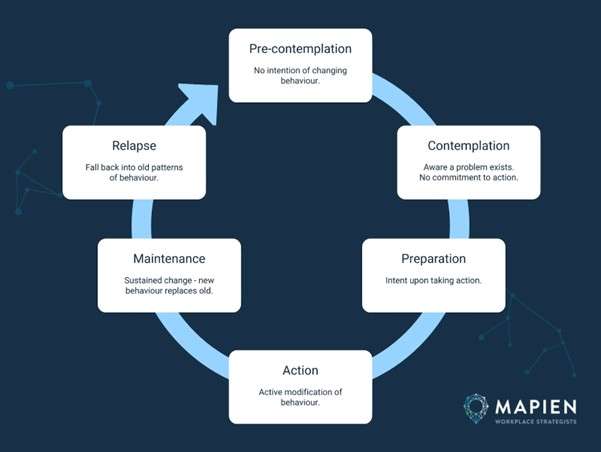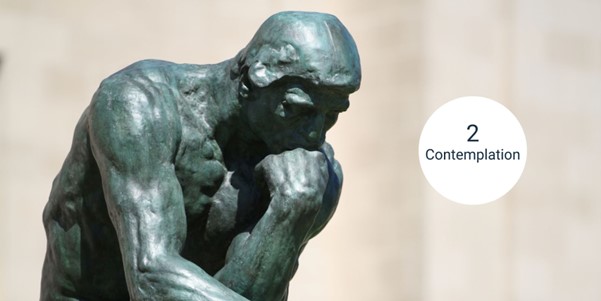
How Leaders Can Use the Stages of Change Model
This is blog #6 in our series on coaching models. Sign up to our mailing list to make sure you don’t miss out on our future content.
Change is necessary for personal growth and development. But going from where you are now to where you want to be is easier said than done (see: all those New Year’s resolutions that died sometime in January).
As a leader, you’ve probably also noticed that it’s even harder to get someone else to make a change.
Fortunately, we have a tool for that. The Stages of Change Model can help you better understand how to support someone through a change, even when it seems like they’re going backwards (spoiler alert: that’s part of the process!).
So, let’s take a closer look about what it is and how you can apply it…
Introducing the Stages of Change Model

Quite simply, the Stages of Change Model helps you visualise the decision-making process a person goes through when preparing for or undergoing a change.
The six stages in the model range from pre-contemplation through to awareness, action, and maintaining sustained behavioural change. If a person relapses into their old patterns of behaviour, they can simply repeat the cycle again – but with new learnings that increase their likelihood of success.
The model demonstrates that:
- People don’t change their behaviours or attitudes quickly or easily
- You cannot force a change — people have to want to change
- Changes typically occur through a gradual and cyclical process
- Different strategies can be helpful at different stages
Origins of the Stages of Change
The Stages of Change Model is part of the Transtheoretical Model of Change – a theory used in therapy that can be used to understand behavioural change. This theory was developed from the late 1970s onwards by Professor of Psychology, James O. Prochaska and his colleague, Carlo Di Clemente.
Transtheoretical therapy has been clinically tested and proven effective in treating all sorts of health issues, from smoking and alcohol abuse to weight control, exercise, and preventative medical care.
Both transtheoretical therapy and the Stages of Change Model have remained both popular and influential over the decades.
The 6 Stages of Change
Each stage comes with different actions, challenges, and strategies that can support an individual through the change process.
1. Pre-Contemplation

When they are at the first stage of change, an individual isn’t usually aware of any issues with their behaviour or the situation. As such, they don’t yet intend to make any changes. Someone at this stage may also be in denial about their problematic behaviour, or believe that they can’t control their behaviour.
COACHING TIPS:
- Ask: Why do you think this change is needed?
- Ask: What are you risking if the situation doesn’t change?
- Discuss: Provide information and feedback that might help the person become aware of the problem.
2. Contemplation

When someone enters this stage, they are starting to think about making a change in the foreseeable future (within 6 months). This means they are probably recognising some of the positives associated with changing a situation or behaviour, but the negatives also weigh heavily. For instance, changing their behaviour might lead to temporary pain or disruption, it might be costly, or it might take up valuable time.
COACHING TIPS:
- Ask: What positives and negatives might come from making a change or not making it?
- Ask: What might prevent you from making a change?
- Motivate: Talk about the benefits of changing and any potential consequences if things were to remain in their current state.
3. Preparation

Once someone reaches the preparation stage, they are getting ready to make a change in the immediate future (within 30 days). In order to get ready for a bigger change, they might start experimenting and making progress with smaller changes. This might include booking a session with a coach, reading a book with relevant information, purchasing necessary products, or joining a community of other people who are on a similar path.
COACHING TIPS:
- Ask: Why are you motivated to make a change?
- Ask: What steps do you need to take to make a change?
- Plan and strategise: Work together to come up with change strategies they could try that would be realistic to implement, appropriate for the situation, and likely to be effective.
4. Action

Once they reach this point, a person is taking direct actions to achieve a change in their behaviour or situation. They intend to persist with the change, despite experiencing some challenges — and are likely experiencing some wins as a result (though these wins may not be enough for long-term, sustained action).
COACHING TIPS:
- Ask: What has been easy for you during this change? And what’s been difficult?
- Ask: What can you do to address the challenges that have come up?
- Practical Support: Help the person take steps towards making change. Provide reinforcement and encouragement to keep moving forward.
5. Maintenance

A person is considered to be in the maintenance stage when they have maintained the change in behaviour or situation for a reasonable amount of time (6 months is a good milestone) and intend to continue. Minor setbacks may occur, but overall, they avoid temptation and stay on track.
COACHING TIPS:
- Ask: What has helped you to maintain the changes you’ve made??
- Ask: What else can you do to maintain this change in case you experience setbacks in future?
- Proactive Support: Help them become aware of the possibility of relapse and identify strategies that will help them maintain their current progress.
6. Relapse

Finally, it’s important to understand that relapse is extremely common when making a change. Setbacks can occur that cause someone to go back to their previous negative behaviour or situation. Although they will likely feel frustrated and disappointed at relapsing, they should take the opportunity to learn about themselves, their triggers, and any barriers to success so that they can implement strategies to manage them in future.
COACHING TIPS:
- Ask: What do you believe triggered you and caused this relapse?
- Ask: What can you learn from this relapse? And what can you do to prevent future relapses?
- Reflect: Help them reflect on the situation and identify potential learnings, and guide them back to their original commitment and goal.
Completing the Cycle
Some interpretations of the model suggest that there is no end state or completion of the cycle. In this case, the goal is to simply remain in the maintenance stage, avoiding triggers and relapses as much as possible.
However, other interpretations are that once a person is successful with implementing the change, they may eventually reach an end state where the change is permanently embedded in their lifestyle or identity. This means that no triggers or temptations will cause them to relapse or return to their former state, and the cycle ends.
Neither interpretation is necessarily right or wrong — so coaches may wish to adopt the version that best fits the mindset of the individual they’re working with.
Starting with the Stages of Change
The Stages of Change Model is a valuable tool for coaches, therapists, and leaders to use in supporting others through a situational or behavioural change.
However, it does have one key limitation to bear in mind:
“People have to want to change.”
Even the most compelling information, careful coaching, and active support may not be enough. The individual must be prepared to commit to the change, as it will likely require both time and effort on their part.
In some situations, before you get started with the Stages of Change, it may be helpful to first employ a mix of other coaching methods and models, such as the GROW Coaching Model, the Circles of Control, Influence & Concern, and The Choice Point Method. These may provide further insights into behaviour or motivation that can help someone commit to making positive changes.
That said, assuming you’re coaching someone who is ready and willing to make a change, the Stages of Change Model is a practical tool to guide them along the way — increasing the chances of positive, long-term change.
Connect with us!
If you’re experiencing any personal changes or changes in the workplace, you (and potentially your team) could benefit from some extra support to work through them. Reach out to our team if you’d like support with leadership coaching and access to more tools like this one.

